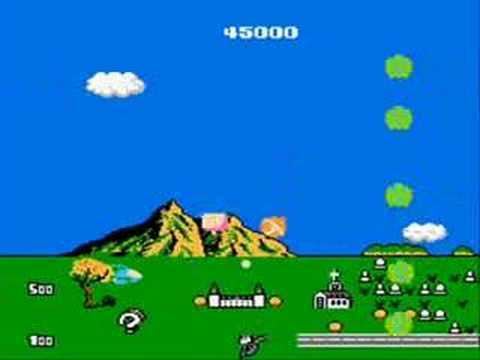Designer(s) Kazuhiro Aoyama Series TwinBee Publisher Konami | Initial release date 21 November 1986 Developer Konami Genre Shoot 'em up | |
 | ||
Composer(s) Kiyohiro Sada (NES, FDS), Shinya Sakamoto (Famicom) Mode(s) 1 or 2-player cooperative (3-player in the Japanese version) Platforms Nintendo Entertainment System, Family Computer Disk System Similar TwinBee games, Shoot 'em up games | ||
Moero TwinBee: Cinnamon-hakase o Sukue! (Japanese: もえろツインビー シナモン博士を救え!, Hepburn: Moero Tsuin Bī: Shinamon-hakase o Sukue!, lit. "Burn TwinBee: To the Rescue of Dr. Cinnamon!") is a vertical/side-scrolling shoot-'em-up game released by Konami for the Family Computer Disk System in Japan in 1986. It was later re-released as a standard Famicom cartridge in 1993. Moero TwinBee was the second game in the TwinBee series, as well as the first of two TwinBee sequels released for the Famicom, followed by TwinBee 3: Poko Poko Daimaō in 1989.
Contents
A North American version for the Nintendo Entertainment System was released in 1987 titled Stinger, making it one of the few games in the series to have an overseas release.
Gameplay
Moero TwinBee can be played by up to three player simultaneously: the first two players control TwinBee and WinBee (the ships from the previous game) using the standard Famicom controllers, whereas the third player controls GwinBee (a green ship) by connecting an additional controller into the console's expansion port. Unlike the original TwinBee, which only featured vertical-scrolling stages, Stinger adds side-scrolling stages to the mix as well. There are seven stages in the game. Stage 1, 3, and 7 are side-scrolling stages, while the rest are vertical-scrolling stages. The controls remain the same between the two styles of gameplay, with the only difference being that in the side-scrolling segments, the A button shoots hearts over the ship instead of dropping bombs into the ground like the vertical-scrolling segments, which helps the player keep the power-up bells afloat in the side-scrolling stages.
The player's primary power-up items are once again bells that uncovered by shooting floating clouds throughout the stages. There are six types of bells in this installment: the regular yellow bells give the player bonus points as usual, the blue bells increases the ship's speed; the white bell upgrades the player's gun into a twin cannon; the pink bell gives the player a laser beam cannon; the flashing pink/white bell gives the player's ship mirror options for added firepower; and the flashing blue/white bell will surround the player's ship with a barrier for extra protection from enemy fire. Some power-ups are mutually exclusive, such as the white and pink bells. Other power-ups can be obtained by destroying ground enemies such as a moon item and star item which gives the player's ship a three-way shot and a five-way shot respectively. If two players are playing the game, they can align their ship together to turn their gun into a ripple laser.
Regional differences
Stinger, the NES version, only allows up to two players simultaneously, as it predated the release of multiplayer adapters such as the Four Score and Satellite. The second player controls GwinBee instead of WinBee, who is absent from this version. The NES version also lacks the opening and ending screen showing the three grandchildren of Dr. Cinnamon, as well as the selectable difficulty settings at the title menu.
